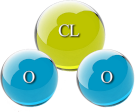Reports from Dr. Vet Dirk Schrader
Further promising results in tumor therapy with - chlorine dioxide
by Dirk Schrader
We are increasingly presented with tumor cases that are deemed “inoperable” due to their highly malignant nature.
These include, for example, spindle cell sarcomas, hemangiosarcomas, and other particularly aggressive tumors. According to the recommendations of veterinary training centers, such tumors are not surgically removed because their margins are not, or are rarely, clearly distinguishable from healthy tissue. As a result, the typical prognosis is: “Your dog has only a few weeks left; you should consider euthanasia.”
However, we have been successfully removing spindle cell sarcomas in the oral cavity for years using plasmasurgery. After successful therapy with chlorine dioxide injections—for instance, for lymphatic leukosis (lymph gland cancer) in dogs, thyroid tumors, and soft tissue tumors—we have found that, as of the end of 2023, spindle cell sarcomas located under the skin, in connective tissue, and muscles can also be effectively treated with chlorine dioxide injections.
The extensive findings on chlorine dioxide and its effects are shared by COMUSAV (Coalición Mundial Salud y Vida), an association of doctors worldwide. These findings are based on the information regarding the use of chlorine dioxide by Andreas Kalcker. While these applications may not be directly transferable to veterinary medicine, they are fundamentally applicable.
On November 29, 2023, the B. family from the Ruhr area brought in their dog Polar, a 9-year-old male French Bulldog. He exhibited a thickening in the left neck area approximately the size of a man's fist. After visits to several veterinarians and a tissue analysis at the University of Veterinary Medicine in Hanover, it was confirmed that Polar had a “non-operable spindle cell sarcoma,” with a life expectancy of just a few more weeks.
Following quantum analysis, it was decided to administer intratumoral chlorine dioxide injections. In the meantime, the malignant tumor has shrunk to less than “golf ball size.” The B. family administers chlorine dioxide rectally to Polar three times a day, along with 50% DMSO. It remains to be seen whether Polar will need to return to Hamburg for further treatment.
A lot has changed for him nutritionally—Polar looks completely different now: he has a shiny coat and high vitality. He receives all the nutritional supplements that are beneficial for humans, including vitamin D3.
I would like to thank the B. family for their decision to use chlorine dioxide. We are at the beginning of a new era.
Canine lymph node cancer - a new and successful therapy in the year 2023
by Dirk Schrader
We have known about this nasty disease in dogs for decades: The neck lymph nodes are suddenly clearly palpable, as are the lymph nodes in the hind legs—and they all get bigger and harder. Real “lumps” appear in the neck area. The dog appears dull. The blood count is typically altered. There are therapies that can actually “help”: The German veterinary profession resorts to cortisone and “chemo.” The average survival time is five months, costing many thousands of euros.
Many pet owners decide against chemotherapy. They may have read the book "Chemotherapy Cures Cancer" and "The Earth is a Disk," or at least heard of it.
The publications by Hartmut Fischer (Das DMSO-Handbuch) and those by Andreas Kalcker and COMUSAV point to a therapy that has been with us for 15 years and has produced better results than conventional medicine: the use of chlorine dioxide and DMSO. Dog lovers are actually keeping their dogs suffering from lymphatic cancer alive for an unusually long time with daily doses. We are aware of “cases” where lymph gland cancer has been completely neutralized. However, everything depends on the correct dose, frequency, and regularity of administration, which is where some dog owners can fail.
Dirk Matthies did not fail. He treats his dog Tschako, an older Hollandse Herdershond born in 2016, since the summer of 2022 with chlorine dioxide produced according to the Schrader method and a 50% DMSO solution—all orally by arrangement. And Tschako is doing well—as if he had nothing wrong. Only the “lumps” somehow got bigger, and it was decided to use direct current therapy according to Pekar. When Tschako was under anesthesia, it became clear that this therapy could not be the right one because there were now over 20 of these large and small lymph node tumors.
At some point, I had seen a video in which South American doctors treated a woman with advanced breast cancer with just one (!) injection of chlorine dioxide—the video was absolutely credible. And so it happened: Tschako received a “concentrated load” of aqueous chlorine dioxide solution into each tumor, prepared according to Schrader. The tumors were literally “pumped up.”
The colleague who had the confidence to carry out this procedure and who was dedicated to it obviously had experience with “intratumoral application” of spider toxins and others.
Today, on April 12, 2023, Dirk Matthies visits us and shows us his dog: Tschako is in the best of health—without restrictions—the lymph nodes that could be felt at the time are gone. No longer palpable. The operation was 10 days ago. Unbelievable!
Confidence spread, and we agreed that the oral chlorine dioxide/DMSO therapy should be continued.
Dirk Matthies has opened a door that we as vets only had to walk through.
I thank him from the bottom of my heart and will continue to report on Tschako.
